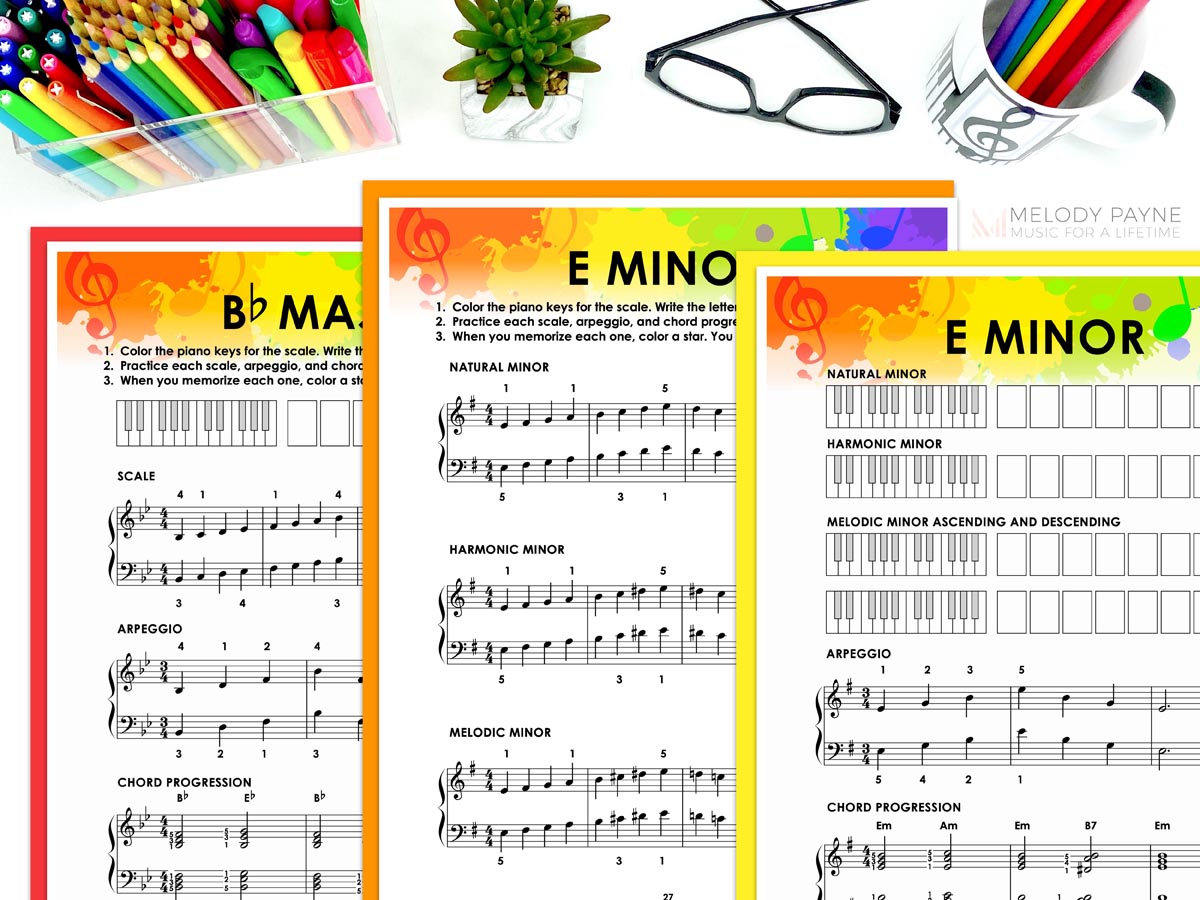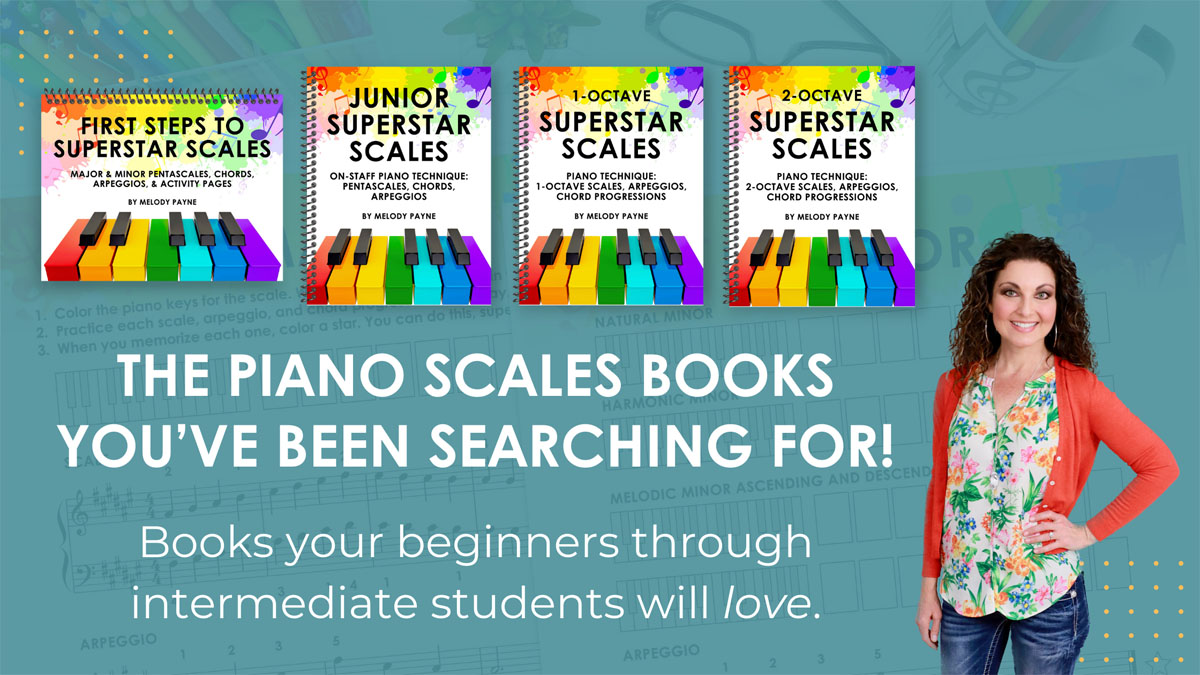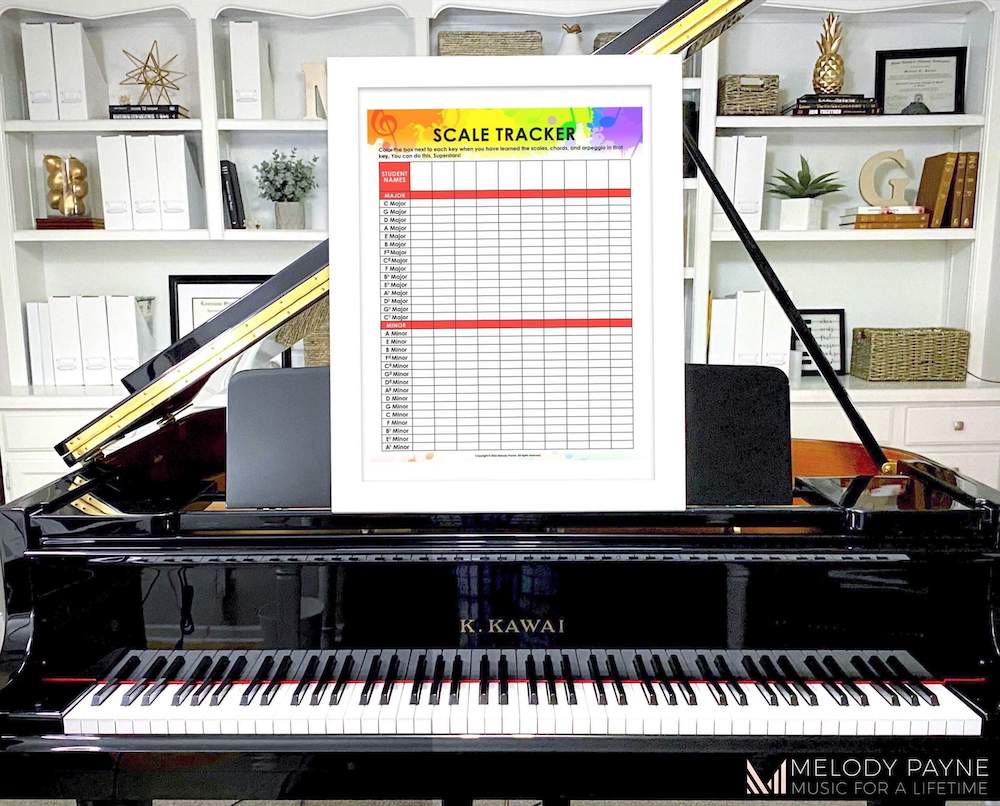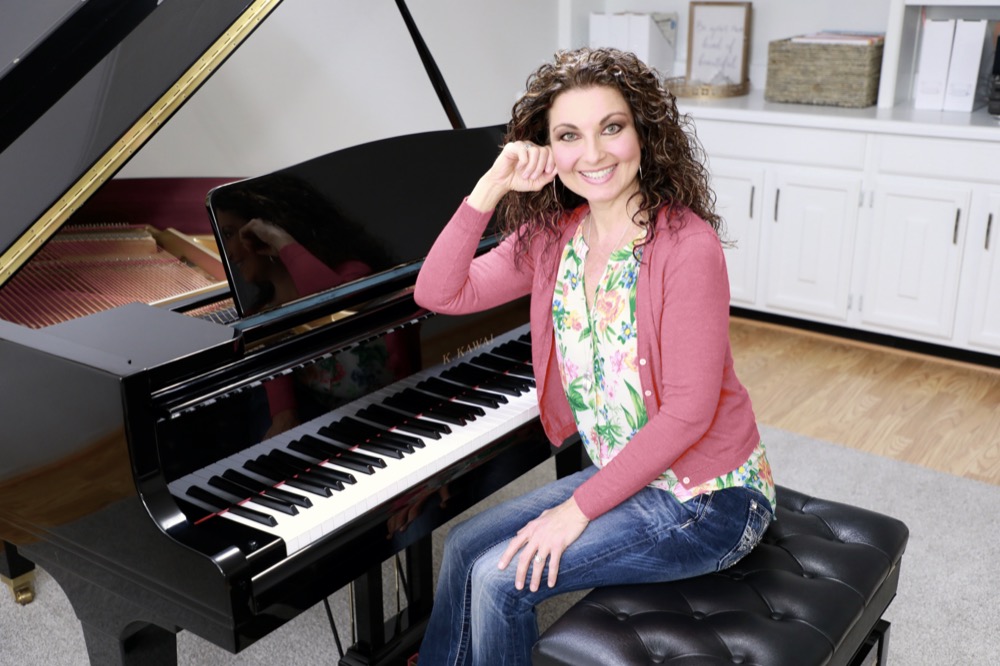Teaching Scales – Essential Tips Every Piano Teacher Needs to Know
This post may contain affiliate links. If you purchase something through an affiliate link, I will receive a small commission at no cost to you. For more information, read the disclosure statement here.

Have you ever wondered, “Do I really need to be teaching scales to my piano students?” or “Is teaching scales that important and necessary?”
The answer, as you’ll discover in this blog post, is a resounding yes!
Scales, chords, and arpeggios are the building blocks of music.
Scales not only make sight-reading easier but also equip your students to instinctively know what keys to play when they encounter a scale passage in a new piece of music.
Teaching scales broadens your students’ understanding of music theory and lays the groundwork for their musical development.
Here are my favorite tips for teaching scales.
Why Scales Should Matter to Your Piano Students
Why should piano students learn scales? Here are a few of many reasons that come to mind.
- Scales help students develop healthy technique, fine motor coordination, and dexterity.
- Scales can make sight-reading easier and more intuitive.
- Scales aid in understanding different key signatures as students practice pieces in these keys.
- They also give students a better understanding of structure, harmony, and chord progressions in music, which can deeply enrich their overall musical comprehension.
And all of these things make learning piano easier, which might be your students’ favorite reason for practicing scales!

My Favorite Tips for Teaching Scales
When teaching scales, I always start with the C Major Scale, the most beginner-friendly major scale from a visual and a key signature standpoint.
C major is also the most common key many beginners are playing in.
I begin by introducing the pentascale and then teach the one-octave scale when the student is ready.
Here are a few ways I approach teaching scales with my students. Each student is unique and different, so I have a variety of approaches from which to choose.
Introducing the C Major Scale
If my students are visual learners, this approach works very well.
First, I show my students that C major spans the white keys from one C to the next C.
Then I have my younger students walk the C Major scale on my giant vinyl floor keyboard, naming each piano key as they walk the scale.
Next we move back to the piano and practice playing right hand fingers 1-2-3- on C-D-E. Then I show them how to tuck their thumb under to play F.
Then we use fingers 2 through 5 to play G up to C.
We play the right hand ascending scale a few times before attempting the descending scale.
This is all done hands separately for the first week because I want to be 100% sure the correct fingers are being used for every note.
Teaching the Whole and Half Step Major Scale Formula
Some students who are more concrete prefer learning the scale formula before learning the scale, so this is the approach I use with them.
First, I explain that scales are built on patterns of whole and half steps.
Then we review whole and half steps to ensure my students remember what they are.
Then I give them the major scale formula: X-W-W-H-W-W-W-H, where X is the starting note, W is a whole step, and H is a half step.
I lead them to discover the C Major scale by helping them apply the formula beginning on C.
Then I help them apply the formula to other piano keys and lead them to discover how this formula can be used to build any other major scale starting on any note.
Then we add the correct finger numbers and play the scale.
Teaching Other Major Scales and Minor Scales
Once students feel confident with the C Major Scale, it’s time to explore other major scales.
We can easily do this visually with the floor keyboard, by using the major scale formula, by using the circle of fifths, or all of the above.
I personally prefer a combination of every approach.
The more ways I can help my students experience a new concept, the more likely they will remember it!
I love tapping into multiple senses. Sound, feel, sight… This creates a solid learning process that ensures students will remember their scales from week to week.
Using the Circle of Fifths for Teaching Scales

The circle of fifths is a valuable tool that makes it easy to teach scales in a specific order. We make our way around the circle from C Major to E Major.
After my students are comfortable with these 5 major scales, I introduce relative minor scales, beginning with A Minor.
I teach my students that the relative minor for any major key is three half-steps (a minor third) below the major and shares a key signature with the major key, much like two siblings can be very unique and different from one another yet share the same last name.
We begin on C, count three half steps lower, and discover that A Minor is the relative minor to C Major.
Then I use the circle of fifths to visually show them the relationship between C Major and A Minor.
Additional Resources for Teaching Scales

If you’re looking for a comprehensive resource for teaching scales to your beginner to intermediate students, I highly recommend the Superstar Scales series.
These scales, chords, and arpeggios books are colorful, clear, and wonderfully straightforward, making the learning process enjoyable for beginner to intermediate students of all ages.
They also include a colorful circle of fifths that can be printed and placed in each student’s piano binder for reference, or printed poster-sized and displayed in your studio.
Tips for Keeping Scales Interesting
Practicing scales doesn’t have to be dull and monotonous.
In my studio, we hold a fun and competitive Superstar Scales Challenge to encourage my students to practice their scales on a daily basis.
Superstar Scales Challenge

The rules are simple:
- Each student is assigned one to two scales to practice each week: Pentascales for beginners and one-octave scales or two-octave scales for elementary and intermediate students.
- For each scale, chord, and arpeggio a student plays correctly, they receive a checkmark on the Superstar Scales Challenge Chart.
- The student who learns the most scales, chords, and arpeggios in the allotted time wins!
The Superstar Scales Challenge a terrific motivator!
Modifying Scales
Students can also explore a variety of rhythms, styles, dynamics, and even use swing rhythms, repeating notes, and more when practicing scales.
Practicing scales using various rhythms helps break the monotony and improves their rhythmic skills.
Playing scales in double-time, dotted rhythms, or using swing-style rhythms can make practice much more engaging and interesting.
Practicing scales with a metronome can improve students’ consistency and sense of pulse.
Having students practice scales with different articulations (staccato, legato, accenting certain beats) and dynamics (piano, forte, crescendo, decrescendo) will help them to develop and deepen their expressive control and make their playing more musical.
Correlate Scales with Music Theory
Scales play an integral role in helping students understand music theory.
With a solid grasp on major and minor scales, students will have a much easier time diving into music theory concepts.
Scales can be used to teach whole steps and half steps, key signatures, intervals, aural skills, arpeggios, chord qualities and functions, and chord progressions, to name a few.
And once students know a few chords and chord progressions, they are better equipped to play lead sheets and improvise with more depth and understanding.
The Power of Teaching Scales
So there we have it – teaching scales not only improves your students’ technique and coordination but also provides the opportunity to introduce a whole world of music theory.
In my studio, scales are an integral part of every piano lesson, helping students grow from beginners to knowledgeable musicians over time.
That’s why I truly believe that teaching scales, chords, and arpeggios can support a new level of musical understanding for our students, opening unlimited doors for their musicianship.
Let’s chat about teaching scales!
I would love to hear about your experiences and tips for teaching scales, so leave a comment below with your favorites!
And remember, if you want to learn more about teaching scales or need the perfect piano scales books for your students, visit melodypayne.com/superstar for scale books for beginner to intermediate students, circle of fifths pages and posters, and individual and studio scale trackers for your scales challenge.
Want to dig deeper into teaching scales?
Here are more blog posts for each level:
- Teaching Beginning Piano Scales to Young Piano Students
- 5 Reasons to Use Junior Superstar Scales with Young Beginners
- Teaching Scales, Chords, And Arpeggios Using The Superstar Scales Piano Technique Book
- 13 Fail-Proof Ways to Teach 2 Octave Piano Scales & Chords
- Introducing the Circle of Fifths to Your Music Students
- 3 Reasons You Need Piano Scale Trackers
Don't miss out!
Follow on Facebook and Instagram, join the best Facebook group for piano teachers, and subscribe to the newsletter to get helpful teaching tips, resources, and tutorials delivered straight to your inbox every week.
Melody Payne
Melody Payne
Welcome!

Hi! I’m Melody Payne, a pianist and piano teacher, educational resource author, a fun-loving wife to the most wonderful and talented hubby I could ask for, and a lifelong learner who loves to share. I want to make your life as a music teacher easier by writing and sharing helpful and relevant music teaching articles, and by creating educational resources with your very own students in mind. If you are a parent who wants to enroll your child in piano lessons, I’d love for us to get started building those skills that can give your child a lifetime of musical enjoyment!


This Post Has 2 Comments
I have always found the circle of fifths an unnecessarily complicated way to find more scales starting with C. I prefer to teach C major as two identical tetrachords (lower and upper.) Then it’s simply a matter of starting a new scale using the upper tetrachord of one scale as the new lower one, and seeing how a sharp has to be added, and the reverse as the flats are added. Makes more sense to me, and my students seem to get it straight away!
That’s the perfect way to use the circle of fifths – showing students the relationship between each scale when adding a sharp or flat. I’m sure your students have a very solid understanding of scales with this approach. Thanks for sharing!